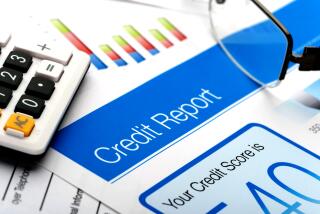Restoring your credit scores after filing for bankruptcy
Dear Liz: I had credit scores over 800 with no late payments ever. Unfortunately, a medical issue required me to charge $24,500 to a credit card. That led to a bankruptcy, which was discharged in July 2011. My scores dropped to 672, and they’re currently around 680. I’m paying two unsecured credit cards in full each month plus an auto loan that was reaffirmed in bankruptcy. I would like to continue rehabilitating my scores by applying for another loan. When a company requests my credit scores, does it also see my bankruptcy, and would that prevent me from getting credit?
Answer: Some lenders look just at credit scores, while others request credit reports along with your scores. Your bankruptcy or your scores could cause lenders to charge a higher interest rate or refuse to give you credit.
It’s not clear that the scores you’re seeing are FICO scores, however. A bankruptcy would have dropped your FICOs into the 500s, and it’s unlikely they would return to the high 600s in less than a year. What you may be seeing are VantageScores, which have a different score range: 500 to 990, compared with FICO’s 300 to 850.
If you want to see your FICO scores, which are the ones most lenders use, you can buy them for about $20 each at MyFico.com. Scores offered at other sites typically aren’t FICO scores but may be VantageScores or “consumer education scores” that aren’t widely used by lenders.
You’re doing the right things by using a mix of credit (credit cards and an installment loan) and paying your bills on time. You should know, though, that there’s no way to quickly restore your scores to their old levels. It typically takes seven to 10 years for FICOs to recover from a bankruptcy.
But let’s back up a minute. You almost certainly made a mistake by charging your medical care to a credit card. You may have been able to qualify for a discount on your care if you hadn’t. Many medical providers offer charity programs that cut or eliminate the bill for people making up to 400% of the federal poverty line. A single person could make up to $44,680 and still qualify for a break under many providers’ programs.
If you make too much to qualify for financial aid, you could still have negotiated a discount by asking the provider to charge you the same rate that its largest insurer pays. The uninsured are often charged a much higher “sticker price” for medical care than what insurers pay, but if asked, many providers are willing to provide the same discounts.
If nothing else, you probably could have qualified for an interest-free payment program. Once you charged the bill to your card, however, you lost all your leverage to get a discount.
Is 3% retirement drawdown rate too conservative?
Question: In a recent column you repeat advice I have often read that withdrawing about 3% of my investment capital will reduce the chances of my running out of money in retirement. But that doesn’t make sense to me. I have been retired for over 19 years and I have sufficient data now to extrapolate that I could live for 100 more years with so meager a drawdown because, through good and bad times, my earnings after inflation and taxes always exceed 3%. If I am missing something, I must be extraordinarily lucky because it hasn’t hurt me yet, and at age 77 I think it unlikely to do so in my remaining years. Can you explain this discrepancy between my experience and the consequences of your advice?
Answer: Sure. You got extraordinarily lucky.
You retired during a massive bull market, which is the best possible scenario for someone who hopes to live off investments. You were drawing from an expanding pool of money. Your stocks probably were growing at an astonishing clip of 20% or more a year for several years. Although later market downturns probably affected your portfolio, those initial years of good returns kept you comfortably ahead of the game.
Contrast that with someone who retires into a bear market. She’s drawing from a shrinking pool of money as her investments swoon. The money she takes out can’t participate in the inevitable rebound, so she loses out on those gains as well. All that dramatically increases the risks that she’ll run out of money before she runs out of breath.
It’s the first five years of retirement that are crucial, according to analyses by mutual fund company T. Rowe Price, which has done extensive research on sustainable withdrawal rates. Bad markets and losses in the first five years after withdrawals begin significantly increase the chances that a person will run out of money during a 30-year retirement.
Some advisors contend that a 3% initial withdrawal rate, adjusted each subsequent year for inflation, is too conservative. If you retire into a long-lasting bull market, it may well be. But none of us knows what the future holds, which is why so many advisors stick with the 3%-to-4% rule.
Questions may be sent to 3940 Laurel Canyon, No. 238, Studio City, CA 91604 or via https://www.asklizweston.com. Distributed by No More Red Inc.
More to Read
Inside the business of entertainment
The Wide Shot brings you news, analysis and insights on everything from streaming wars to production — and what it all means for the future.
You may occasionally receive promotional content from the Los Angeles Times.









